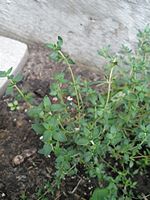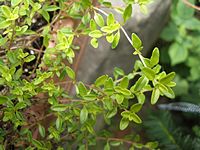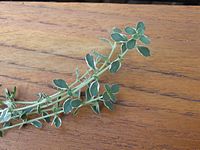What Is Thyme
Thyme is a very aromatic herb of Mediterranean origin. And today, thyme is a staple herb in any kitchen herb garden.
Dried thyme is readily available in the herb section of supermarkets. And thyme plants are easy to find at the garden center.
Thyme is a perennial evergreen shrub that grows low to the ground. Due to its compact growth, thyme varieties are commonly used as a ground cover or border plant. Thymes are also commonly planted in windowsill herb gardens.
Latin: Thymus
Thyme Blossoms
The tiny flowers of the thyme herb bloom in June and July. Bees love these tiny thyme blossoms, that range in colour fom pink to a soft purple. There are also varieties that bloom with white flowers and darker hues of red/pink.
Thyme Varieties
A wide range of thyme varieties exist. The most common thymes have the traditional scent and flavor that we tend to associate with thyme.
Thymes with citrus undertones are also common, with distinct citrus undertones of lemon, lime, and orange. As well as thymes with undertones of spices, such as caraway thyme and nutmeg thyme.
Thyme Favourites
English thyme – most popular variety, and what we associate with the traditional flavor and aroma of thyme
French thyme – flavor is a little sweeter than English thyme, and slightly different in a way that’s hard to describe. Not as hardy as English thyme
Silver thyme – same flavor and aroma as English thyme. Attractive variegated foliage of green leaves edged with white.
Lemon Thyme – has a distinct aroma and taste of lemon. Looks and grows very much like the standard English thyme.
Wild thyme / Mother-of-thyme – creeping thyme that forms a dense mat, and tolerates being walked on, perfuming the air with each step.
Woolly thyme – grayish woolly leaves form a dense low carpet as it grows. Not used in cooking due to its lack of scent and flavor.
How To Grow Thyme
Due to is compact growth and versatility in the kitchen, thyme is a first choice pick for windowsill and container herb gardens.
Thymes are also commonly planted as ground covers, or border plants along walkways.
Thymes are easy to care for plants. They do not require any special attention once they are planted.
Thyme likes full sun, and can tolerate partial shade. Thymes need good drainage to grow healthy, so plant your thyme in well-drained soil – this is one plant that is perfectly happy in sandy soil.
Because thyme plants are commonly found in garden centres in the spring, it is easy to find thyme plants to start from nursery seedlings.
Thyme plants can also be started from seed, or by propagating from existing plants in your or a friend’s garden.
Propagating Thyme. Thyme can be propagated by taking stem cuttings, dividing a mature plant, or by layering. Best time to propagate a thyme plant is in the spring.
Starting Thyme from Seed: Plant thyme seeds indoors about a month before your last frost date. Thyme seeds require about 70 degrees F / 21 degrees C temperature to germinate.
Overwintering Thyme: Although thymes are hardy down to zones 4 and 5, I have found over-wintering thymes is not always reliable. Low growing ground-cover thymes overwinter in the northern zones better than the bushier thymes.
To overwinter thyme in your garden, cover the thyme plants with mulch to protect them from winter’s deep freezes.
In milder climates, you should have no problem overwintering thyme. Mulch for winter protection, if In doubt.
Harvesting and Storage
Thyme sprigs can be harvested for use at any time.
To harvest a larger amount of thyme cut the thyme herb plant back, but no further down than two inches above the base of the plant. Harvest the thyme this way early to mid-season to give your thyme plant enough time to recover. Bulk harvesting your thyme plant too close to winter will jeopardize winter hardiness.
Drying Thyme. Thyme is easy to dry. Tie the thyme stems together and hang to dry easily. Or strip the leaves of the thyme stems and dry on a fine mesh screen.
Freezing Thyme. Thyme also freezes well for winter use. Wrap a few thyme sprigs in plastic wrap, and then freeze these individual packets in freezer bags. Alternately, strip the thyme leaves from the stems, and freeze in ice cube trays.
Cooking With Thyme
Thyme is a versatile herb that goes very well with most foods – meat, fish, vegetables, eggs, cheese are all great seasoned with thyme herbs. Thyme is a staple seasoning in many soups and stews.
7 Tips for using thyme in cooking:
- Bouquet garni – traditional soup and stew seasoning. Tie together sprigs of thyme, parsley, and bay leaf. Toss this packet into the pot when making stews or soup stocks.
- Lemon thyme and citrus thymes in general, are best used fresh as the citrus gets lost in the drying process.
- Drop thyme or lemon thyme into boiling soup last-minute, for a beautiful aromatic touch to the soup.
- Lemon thyme pairs nicely with chicken. Use it when seasoning your chicken for roasting. Or, I like to add a bit of lemon thyme to a simple bread stuffing, before stuffing the chicken for roasting.
- Caraway thyme is an awesome seasoning for beef.
- The tiny delicate thyme blossoms are edible, and can be added to salads or used as a garnish.
- Pair thyme with goat cheese and balsamic dressing for a simple elegant snack or appetizer. Get the recipe here: Marinated Goat Cheese With Thyme
To your herb gardening success,
Barb
Copyright © 2011 www.HerbGardenGal.com. All rights reserved.
_________
Want to use this article in your Ezine or Website? You can, as long as you include the complete article and the Copyright information.


